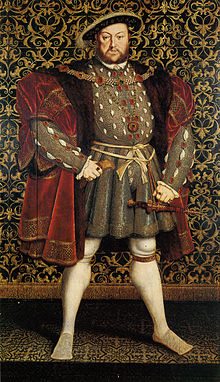Portrait of Henry VIII
The portrait of Henry VIII after Hans Holbein is one of the most famous pictures of a British monarch and the most famous portrait of Henry VIII. In addition to the king, the original mural also showed his wife Jane Seymour and his parents. This mural was destroyed in a fire at the Palace of Whitehall in 1698 . It was handed down in a copy from 1667. After Heinrich's portrait in the family picture, a number of versions were made during his lifetime and are kept in European and American collections.
Historical background
After the death of Cardinal Wolsey in 1529, his estate York Palace came to Henry in 1530, who made the palace his main residence. During his entire reign, the opulent and spacious palace complex, the Palace of Whitehall , was built. In 1536 the king commissioned Hans Holbein to paint a mural depicting Heinrich with his third wife Jane Seymour and his parents Heinrich VII and Elizabeth of York .
In 1536 Heinrich had been king for 27 years and did not yet have a male heir. In the spring of that year he was seriously injured on a tournament field and had to fear for his life. The existence of the Tudor dynasty was seriously threatened at this point. In April 1536, his second wife Anne Boleyn was arrested for allegedly multiple adultery and beheaded on May 19, 1536 in the Tower . The way was now clear for a marriage to Jane Seymour, whom he married on May 30, 1536 in Whitehall. Jane Seymour died on October 24, 1537, only a few days after the birth of her son Edward , with whom she was probably already pregnant when the picture was taken.
The domestic political situation was precarious at this time. In October 1536 a rebellion broke out in the north of his empire , which developed into a serious government crisis. The trigger was, apart from the tightening of the tax screw, the secession of the English Church from Rome and the associated dissolution of the monasteries, the abolition of popular holidays, the declaration of his daughter Maria as a bastard and her exclusion from the line of succession.
When Heinrich died in 1547, he left an underage heir to the throne, a bankrupt state, and a divided nation.
Hans Holbein stayed in England from 1532 with a few interruptions until 1543. At first he worked primarily as a portrait painter for the Hanseatic merchants who had settled there and for members of the nobility, from 1533 he painted portraits of courtiers, and in 1536 he became an official court painter with a fixed salary. His duties included the image of the dynastic rulers in Whitehall, portraying possible further marriage candidates and designing ostentatious and luxury items.
The mural for Whitehall
The image of the ruler for a hall in Whitehall is believed to have been commissioned between 1536 and 1537, the short period of time that Heinrich and Jane Seymour married. This picture was the only mural that Holbein created in England. On the night of January 4th to 5th, 1698, the palace went up in flames, and Holbein's picture also fell victim to this.
According to the description by William Sanderson (1586–1676), who saw the original in 1658, it was an oil painting applied to the wall, not a fresco.
The portrait from the Thyssen-Bornemisza collection
Holbein's only handwritten portrait of the king is in the Thyssen collection in Madrid.
- Data
- Portrait of Henry VIII , around 1536/37
- Oil on oak wood, 28 × 20 cm
- Thyssen-Bornemisza Museum , Madrid
- Inventory No. 191 (1934.39)
The unsigned and undated picture was created after 1536, when Holbein became royal court painter. Shoulders, arms and hands are trimmed, but the king's face and clothing correspond almost exactly to the full figure on Holbein's cardboard and the Whitehall mural, as reported by van Leemput. In the literature, the picture is sometimes seen as a preliminary study for the mural.
The Whitehall box
Of Holbein's preparatory drawings, only a cardboard box with the portrait of the king has survived, which, like the background architecture and the carpet, corresponds to the mural in fairly detail. The contours of the king and parts of the architecture are perforated, so the cardboard was used to transfer it to the wall.
- Data
- Full figure of Henry VIII cardboard mounted on canvas; Pen drawing in black ink, washed with gray, brown, black and red
- 257.8 x 137.1 cm
- around 1536/37
- National Portrait Gallery , London
- Inventory number NPG 4027
As in the Madrid picture, the head and chest are turned slightly from the en face to the right, with the gaze directed towards the viewer, while the king in van Leemput's copy is built parallel to the picture. All the portraits that follow the Whitehall painting adopt this representation.
The paintings
There are two copies of the original mural. The copy from 1667 by the Dutch artist Remigius von Leemput (1607–1676), a collaborator of van Dyck , belongs to the Royal Collection . The copy was commissioned by Charles II and is on display at Hampton Court Palace . George Vertue (1654–1756) copied van Leemput's version in 1737. This picture is also in the Royal Collection.
- Data
- The Whitehall Mural , oil on canvas, 88.9 × 98.7 cm
- dated on the frieze: AN.DO. 1537
- Royal Collection, Her Majesty The Queen Elizabeth II, Hampton Court Palace
- Inv no. 405750
The picture shows four people grouped around a high plinth on a two-tiered plinth. On the right side of the plinth are Heinrich and his father, one behind the other, and on the other side Jane Seymour and his mother. They are built in front of a splendid Renaissance architecture with three shell niches and pilasters and friezes that are richly decorated with ornaments. The entire floor is covered by an oriental carpet that wraps around the plinth.
The plinth and base are inscribed in Latin.
- SI IVVAT HEROVM CLARAS VIDISSE FIGVRAS
- ILIVS TO VINCAT VICIT VTERQVE QVIDEM
- ISTE SVOS HOSTES PATRIÆQVE INCENDIA SAEPE
- SVSTVLIT ET PACEM CIVIBVS VSQVE DEDIT.
- FILIVS AD MAIORA QVIDEM PROGNATVS FROM ARIS
- SVBMOVET INDIGNO SI SVBSTITVITQVE PROBOS
- CERTÆ VIRTVTI PAPARVM AVDACIA CESSIT
- HENRICO OCTAVO SCEPTRA GERENTE MANV
- REDDITA RELIGIO EST ISTO REGNANTE DEIQVE
- DOGMATA CEPERVNT ESSE IN HONORE SVO.
- PROTOTYPVM IVSTÆ MAGNITVDINIS IPSO OPERE TECTORIO
- FECIT HOLBENIVS IVBENTE HENRICO VIII A ° DNI MDCCXVII
- ECTYPVM A REMIGIO VAN LEEMPVT BREVIORI TABELLA
- DESCRIBI VOLVIT CAROLVS II. MBPEHR
Description of the portrait
The portrait shows Heinrich in a brawny imposing pose. The legs are spread apart, the knees are bent in order to balance the mass of the upper body, which is wrapped in velvet, silk and fur and decorated with gold and jewels. The handle on the dagger, ready to take action at any time, he looks down at the viewer. The dominantly protruding brayette underlines the power of the king.
He is dressed in a close-fitting jacket with long sleeves that reach to the knee, over it a heavy, knee-length scarf lined with fur , with white stockings that perfectly model the legs and calves and white cow- mouth shoes . All garments are cut according to the fashion of the time, which is inspired by the lush, imaginative farmhand fashion . He has a beret on his head , which is decorated with ostrich feathers, precious stones and pearl agraffen . The top and sleeves of the jacket, which is belted at the waist with loose straps, are slit. From the slits, which are fixed at regular intervals with gold-set gemstones, the fine linen of the undergarment oozes out in small puffs. The bell-shaped shaft is lined with sable fur, and wide borders embroidered with gold threads line the garment.
Heinrich wears two chains, including the collar of the Order of the Garter and the corresponding buckle strap on his left knee, he has rings on both hands and a pair of leather gloves in his right hand , a privilege of the nobility in Heinrich's time and linked to certain official and jurisdiction rituals .
All later versions of this individual portrait take over the representation, down to the details, as given by Holbein in the Whitehall picture. There are only deviations in the design of the background, in the color of the doublet and scarf, and in the type of fur with which the scarf is lined.
Portraits
| Museum, collection | date | Dates, notes | Illustration |
|---|---|---|---|
| Art Gallery of Ontario | 2nd half of the 16th century | Hans Holbein the Younger, circle of |
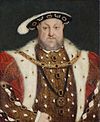
|
| Belvoir Castle | Early 17th century | Oil on canvas, 217 × 147.2 cm |
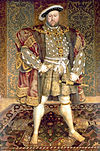
|
| Castle Howard | 1542 | Hans Holbein the Younger, workshop |

|
| Chatsworth House | approx. 1560-73 | by Hans Eworth , probably commissioned by William Cavendish |

|
| Hampton Court Palace | 1667 | Remigius van Leemput , the only surviving copy of the complete mural |

|
| Thyssen-Bornemisza Museum | approx. 1534-1536 | Oil on oak. 28 × 20 cm
Autograph portrait by Hans Holbein |

|
| National Maritime Museum | around 1540 | oil on wood
Workshop copy |
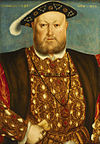
|
| Palazzo Barberini - Galleria Nazionale d'Arte Antica | around 1541 | Elbow; Signed with ANNO AETATIS SUAE XLIV |

|
| National Portrait Gallery | around 1537 | Preparatory drawing by Hans Holbein, cardboard |

|
| National Portrait Gallery |
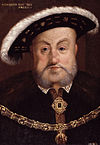
|
||
| National Portrait Gallery | around 1535/1540 | Oil on panel, 57.2 × 42.5 cm
unknown Dutch artist (?) |
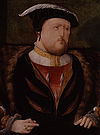
|
| National Portrait Gallery |
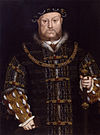
|
||
| National Portrait Gallery |
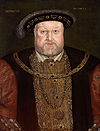
|
||
| New College, Oxford | 17th century? | Oil on panel, 223.5 × 147 cm | Illustration |
| Parham House | after 1560 |

|
|
| Petworth House | Oil on wood; 237 × 120.7 cm
After a dendrochronological analysis, the frame was created after 1525; Workshop copy |

|
|
| Royal College of Physicians | "Henry VIII and the Barber Surgeons"
Oil on oak, 312.4 × 108.3 cm |

|
|
| St Bartholomew's Hospital | after 1702 | Sculpture based on the Holbein painting; partially gold-plated; | Illustration |
| Trinity College, Cambridge | around 1567? | Oil on oak, 229 × 124 cm
Copy by Hans Eworth |

|
| Walker Art Gallery | Oil on oak, 283.2 × 134.2 cm
After a dendrochronological analysis, the frame was created after 1530 |
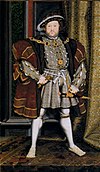
|
|
| Weiss Gallery, London | approx. 1600-1610 | Painted for Sir Henry Lee, kept in Ditchley Park until sold by Harold Arthur Lee-Dillon in 1933; from 2012 owned by Weiss Gallery |

|
| Windsor Castle , Royal Collection | 1535-1544 |

|
|
| Windsor Castle , Royal Collection | approx. 1538–1547? | Oil on panel, 99.8 × 74.2 cm
Elbow |

|
| Windsor Castle , Royal Collection | 1550-1650 |

|
|
| Windsor Castle , Royal Collection | 1550-1599 |
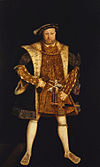
|
Reception, parodies
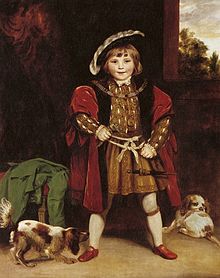
In 1775 Joshua Reynolds portrayed his nephew in the pose of Henry VIII. The Pre-Raphaelite William Holman Hunt painted his five-year-old nephew Teddy Wilson as "The King of Hearts" in the pose and clothes of Henry VIII, but with playing balls and a herald's shield with a red heart. Hunt's version has been marketed in countless posters, on magnetic sticks and as a puzzle.
The life of Henry VIII has been filmed countless times, the first time in 1911, and the Holbein portrait has always been the standard and inspiration for actors and directors. In 1933 Charles Laughton played the role of Henry in the film The Private Life of Henry VIII . In preparation for the film, Laughton visited Hampton Court to study the figure of the king on the van Leemput copy. Later film productions, such as the BBC costume series Six Wives of Henry VIII from 1972 with Keith Mitchell and in Carry On Henry with Sidney James in the leading role, were also based on Holbein's image.
literature
- Stefanie Bruck: Holbein at the court of Henry VIII Reimer, Berlin 1997.
- Susan Foister: Holbein in England . Tate Britain, London 2006, ISBN 1-85437-645-4 .
- Xanthe Brooke, David Crombie: Holbein's Portrait and its Legacy. Holberton, London 2003, ISBN 1-903470-09-9 .
Web links
- Derek Wilson: Was Hans Holbein's Henry VIII the best piece of propaganda ever? In: The Telegraph. April 23, 2009.
- Portraits of King Henry VIII: Hans Holbein and His Legacy. 33 illustrations
- Tudor England: Images. Portrait of King Henry VIII
Individual evidence
- ↑ William Sanderson: graphice. The Use of Pen and Pencil or the Most Excellent Art of Painting in 2 Parts . London 1658. Quoted in Bruck 1997, p. 109.
- ^ Thyssen-Bornemisza Collection
- ↑ Family portrait of Henry VIII (copy after Holbein)
- ^ The Whitehall Mural
-
↑ Translation quoted from Bruck 1997, p. 120.
“If you are pleased to see the figures of famous heroes, look at them. No picture showed larger ones. There is great competition, quarrel and search, whether the father or the son wins. Each of them was certain to be victorious. The former has often torn away his enemies and fended off fires from the land. The Son, born surely for greater things, removed the unworthy from the altar and replaced them with the righteous. The presumptuousness of the Popes is handed over in unswerving virtue, while Henry VIII holds the scepter in his hand, the religion is renewed and under his rule the laws of God began to be honored. ”
Inscription on the base:“ The original in fair size this Holbein created the work as a wall painting on behalf of Henry VIII. Charles II asked for a reduced copy from Remigius van Leemput. In the year of the Lord 1667. " - ↑ HRG digital, keyword glove
- ^ Portraits of King Henry VIII: Hans Holbein and His Legacy.
- ↑ The King of Hearts ( Memento of the original from February 22, 2014 in the Internet Archive ) Info: The archive link was inserted automatically and has not yet been checked. Please check the original and archive link according to the instructions and then remove this notice.
- ^ Henry VIII in Film and Television
